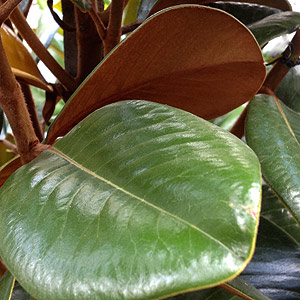
Magnolia ‘Teddy Bear’ is the newest release of the dwarf or small, growing evergreen magnolias and is now readily available for sale in most states.
Foliage differs in that is much more ’rounded’ than its relatives tightly held and with a lovely velvet backing that adds interest throughout the year.
Probably the smallest growing of the ‘dwarf’ magnolias Magnolia Grandiflora ‘Teddy Bear’ makes an excellent landscaping tree, hedge or a specimen tree
Large perfumed flowers, strong growing and tolerant of cold conditions, although like most evergreen magnolias ice can be a problem, with foliage browning, however new growth seems to help the plant recover.
Growing conditions should be similar to its relatives, a moist but well drained soil and a sunny position. Growth rate will be quicker in warmer climates.
Care
Water well for the first two years and provide a cool root run by mulching well. After settling in water is usually only required during summer or dry periods.
Can be pruned to keep a more compact growth habit if required.
- Growth rate is average around 6′ in 4-5 years and eventually reaching 15′ with a spread of 10′ depending on conditions.
- Can also be grown in a large pot or container if pruned to maintain a smaller size.
- Grows well in Zones 7-9.
- Overwatering or poor drainage are the main problems.
- Over fertilising can also be a problem.
- Generally these plants require little care once established except pruning to size if required.
Pruning
Evergreen magnolias are particularly easy to prune. Once established they can be almost cut back to stump and will recover well. If you wish to keep your Magnolia Teddy Bear pruned to a nice small shape, or a formal hedge, then we suggest tip pruning from a young age.
As these plant have large leaves they do not look great when pruned with shears. They are best hand pruned with loppers or seceateures. And as they are not really that fast growing, pruning will be once every year or two.
Zone
Best suited to USDA zones 7 – 9.

